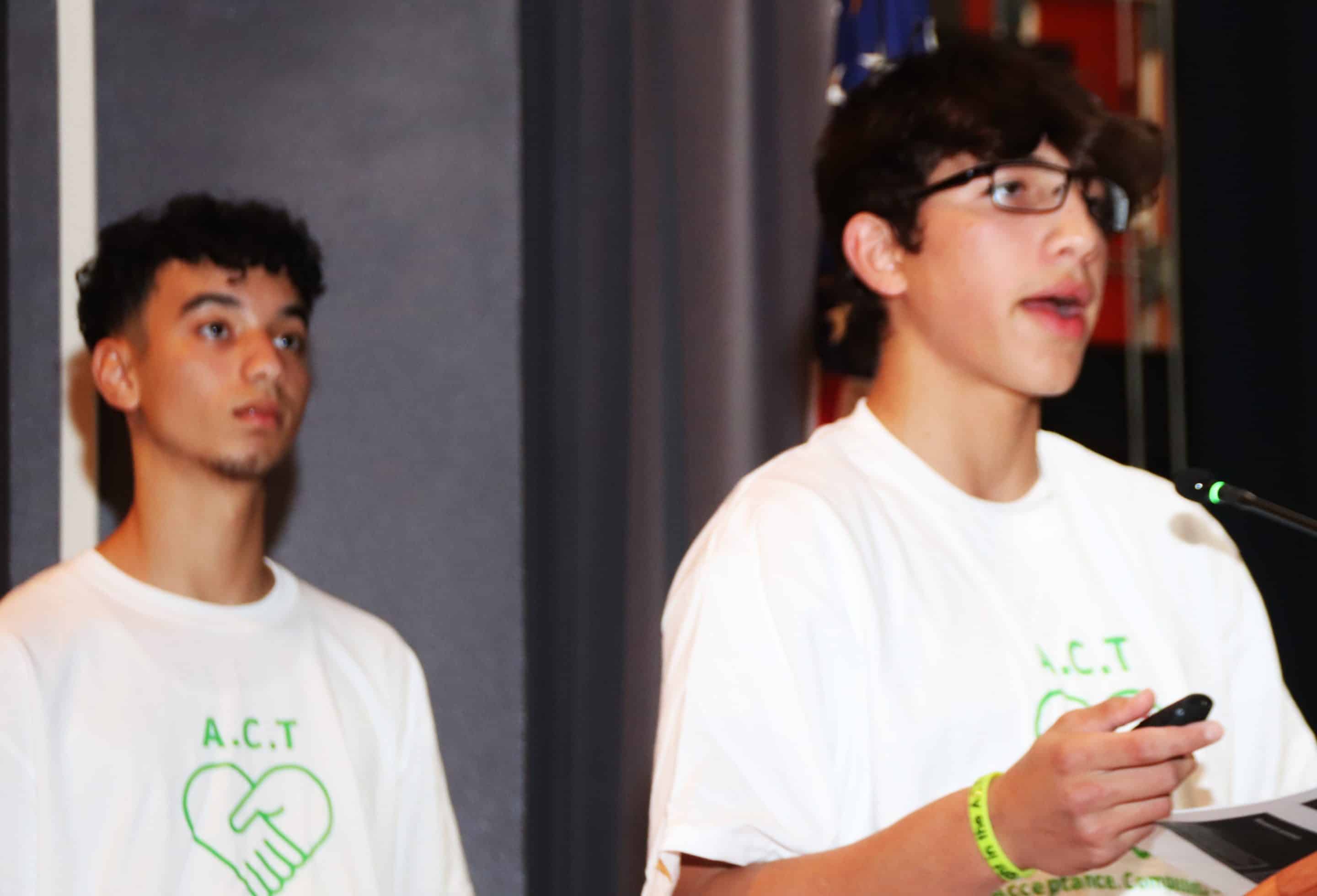At the Oct. 15 School Committee meeting, Agawam High School juniors Omar Elgendy, left, and Jordin Agosto shared information about a new student-led project that focuses on social-emotional learning and preventing targeted violence.
Reminder Publishing photo by Mike Lydick
AGAWAM — A new student-led project is focusing on social-emotional learning to prevent targeted violence by fostering acceptance, compassion and trust.
Marlene DeJesus, the district’s director of social emotional learning, and Sadie Petta, an English teacher at Agawam High School, told the School Committee at its Oct. 15 meeting that the project, Caught in the ACT, is an initiative centered around giving students a voice and being involved in some decision making.
ACT, is an acronym for the values of acceptance, compassion and trust. DeJesus said the project, launched in March, is an initiative that was developed by the Safe and Supportive Schools Student Advisory Group at the high school.
“Research shows that the more students have a voice — and a choice — within the school atmosphere, they’re really going to do much better emotionally as well as perform much better in academics,” said DeJesus. “Those students who believe they have a voice are seven times more likely to be academically motivated than those who do not feel they have a voice.”
Petta said students also had the opportunity to partner with a group called Invent2Prevent that is funded through the U.S. Department of Homeland Security’s Center for Prevention Programs and Partnerships. The program challenges high school and university students to create and implement initiatives, products and tools to prevent targeted violence, hate crimes and terrorism.
“It’s about empowering students to have peer-to-peer initiatives to prevent any targeted violence,” said Petta.
She said that Invent2Prevent partners with schools and provides an online platform to create initiatives, ideas and agendas as well as curriculum. They also provide $1,000 to implement projects like Caught in the ACT.
“Seniors in the project will have the opportunity to get a $5,000 scholarship. They also can be finalists to go to Washington, D.C., to present to other students about what they created. AHS is one of 37 high schools and 25 colleges in the country that are part of Invent2Prevent,” said Petta.
For the presentation, DeJesus and Petta were joined by juniors Jordin Agosto and Omar Elgendy, who are among the nine members of the new student advisory group. They talked about how Caught in the ACT can make a difference for students, schools and the community.
“We want to spread the ACT values throughout our school community, as well as to our town and other schools,” said Elgendy.
The 17-year-old said students involved in the project are “very dedicated” to helping their school community.
“We want to make sure that everyone feels like they belong in our school. We’re very motivated, we’re very passionate in what we do and we always want to make the school a better place for everyone,” said Elgendy.
Agosto, 16, said the goal of the project is to challenge their school — and even the community — to “get caught” using the ACT values to create a more tight-knit community. “Acceptance, compassion and trust are all positive contributions that students, staff and administrators can use to help build school connectedness, which is an area of need identified in our school climate surveys,” he said.
Agosto said this proactive approach ensures that students are connected to community and valued so they avoid at-risk behaviors and school violence by having a clear acronym: “We can empower and challenge students, staff and administrators to do things that represent the entire acronym. It’s a more approachable idea because we use everyday words.”
The students also provided data showing that connectedness improves academic and health outcomes. Agosto told the committee that students in the project compiled data about the district and the state to find out what the percentage of differences was among students in schools around Agawam.
He said that not only did they find that connectedness helps with academics, but also with physical health and social health.
“Connectedness decreases substance abuse and it also helps to create a more diverse group of friends from different social groups who are integrated by race and gender. Connectedness is the strongest protective factor for both boys and girls to decrease substance abuse, school absenteeism and violence.”
Summarizing what the research data showed, Elgendy said that schools with lower connectedness had 48% to 66% higher odds of health risk behaviors and experiences in adulthood, such as drug use and depression, Students in schools with high levels of connectedness are 35% more likely to graduate from high school and 21% more likely to attend college.
Agosto said school communities want to be more connected and united. “We want to make our school community a better place. We want to embrace difficulties and learn to grow from those difficulties,” he said.
Ultimately, he said the project will not only allow for students to feel safe at school, but also to feel “comfortable and happy” being at school.
“Eventually, we want ACT to be integrated into the schools, so students can understand the difference between being kind and actually being a genuine person,” he said.


